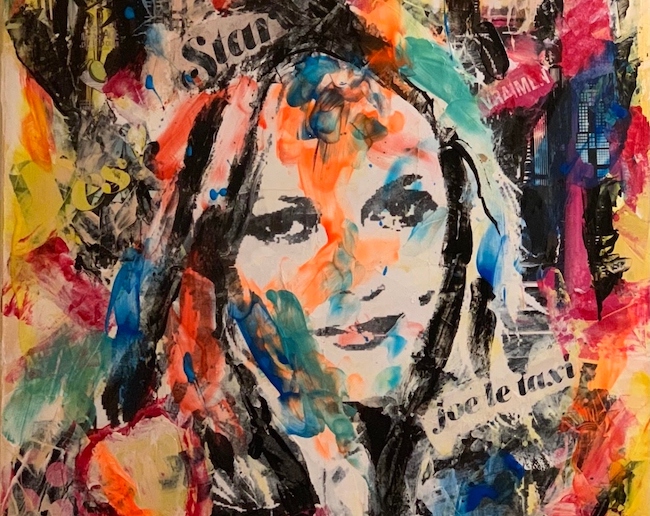La contemporaneità nell’arte presenta la singolare caratteristica di essere un punto di unione, una connessione tra forme espressive differenti che apparentemente potrebbero sembrare opposte eppure in grado di armonizzarsi e dar vita al nuovo che costituisce l’essenza stessa della creatività. Così la manifestazione artistica diviene ricerca, sperimentazione, non solo narrazione di tutto ciò che appartiene all’interiorità bensì un tentativo di coniugare l’effimero con il sostanziale, l’apparenza con l’essenza. Esattamente questa abilità stilistica di muoversi su due fronti diversi eppure amalgamabili, è ciò che contraddistingue la protagonista di oggi.
Intorno alla metà del Ventesimo secolo, quando tutte le correnti pittoriche precedenti avevano combattuto la loro battaglia ideologica contro il Classicismo, la figurazione e i dogmi accademici su cui si era basata l’arte fino a tutto l’Ottocento, cominciarono a delinearsi nuovi movimenti che da un lato cercavano di riappropriarsi del contatto con il mondo interiore, quell’emotività messa in secondo piano nel percorso di analisi, di ricerca della modalità per far prevalere il gesto plastico sulla realtà osservata e il distacco da qualunque accenno alle regole della pittura precedente, dall’altro andavano verso una rappresentazione della nuova società dell’epoca con tutte le caratteristiche che la contraddistinguevano. L’Espressionismo Astratto recuperò tutte le connotazioni emozionali che con l’Astrattismo Geometrico, il Concettuale, l’Informale Materico, lo Spazialismo, solo per citare alcuni tra i principali movimenti, erano andate perdute, riaffermando con forza e impeto l’importanza dell’ascolto dell’interiorità, la capacità interpretativa sull’osservato tipica dell’artista che non poteva slegarsi dal gesto plastico; d’alto canto la Pop Art si proponeva di proseguire il percorso di analisi del vivere contemporaneo non solo accantonando le emozioni se non quelle legate all’inseguimento del consumismo o del mito ormai in grado di entrare nelle case delle persone, ma anche compiendo un riavvicinamento all’immagine, alla figurazione funzionale ad avvicinare all’arte il grande pubblico attraverso un linguaggio familiare, conosciuto. Apparentemente distanti eppure incredibilmente simili per intento artistico, Jackson Pollock e Andy Warhol vollero entrambi trovare un dialogo più diretto con il pubblico, cercando di far uscire l’arte dai salotti intellettuali e andando verso le persone, quelle che pur nella non conoscenza delle regole pittoriche avrebbero potuto sentirsi coinvolte dall’impeto emotivo, nel caso dell’Espressionismo Astratto, o dalla conoscenza dei soggetti ritratti perché appartenenti alla loro quotidianità, nel caso della Pop Art. Dal Dripping più irruento di Jackson Pollock e dal Color Field più meditativo di Mark Rothko si passava così nella stessa epoca ai personaggi dei fumetti mescolati al puntinismo di Roy Lichtenstein o ai miti del cinema a tinte forti di Andy Warhol, entrambi gli stili in grado di coinvolgere e appassionare il pubblico. L’artista di origini rumene ma residente da moltissimi anni a Bruxelles Anca Codrea mescola insieme i due stili per generare un suo linguaggio personale in cui il Pop cerca di prevalere sull’Astrattismo e l’Astrattismo si rivela co-protagonista in grado di esaltare e mettere in evidenza le icone dei fumetti, della filmografia, della musica di un passato idealmente lontano ma temporalmente ancora prossimo alla contemporaneità.
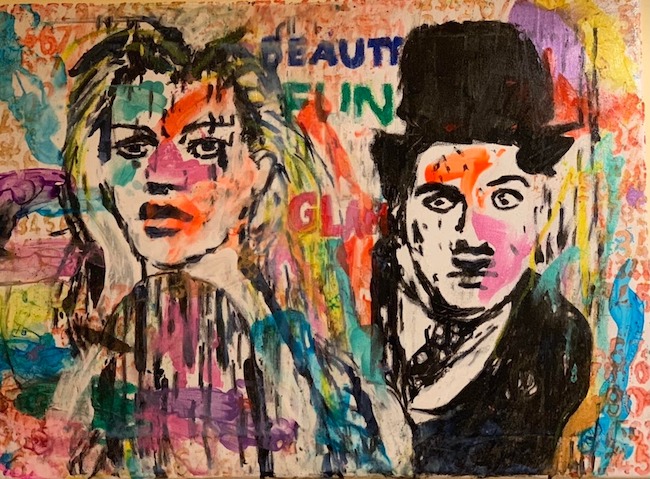
Non solo, Anca Codrea azzarda binomi improbabili, come quello che ipotizza nella tela Kate and Chaplin, dove l’indimenticabile Charlot osserva di nascosto, come nella celeberrima foto tratta dalla pellicola Il monello, la bellezza di una Kate Moss inconsapevole, che si mostra imbronciata all’osservatore, come se in fondo la sua vita, ambita da molte ragazze, fosse noiosa, ripetitiva, insoddisfacente per quelle corde interiori a cui ciascun essere umano tende. Ed è Charlot a ricoprire quel ruolo umano nella tela, quell’essere tenero, giocoso, curioso e sensibile che ristabilisce l’equilibrio tra forma ed essenza; il colore è steso in maniera astratta, irregolare, un po’ attraverso un leggero Dripping e un po’ apponendo tocchi casuali, per dare il senso di irrealtà già evidente dall’accostamento dei due protagonisti.
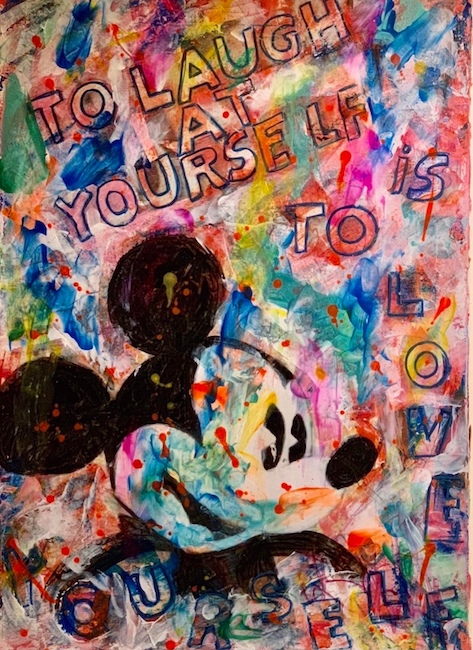
In Mickey la Codrea lascia uscire tutta la sua vena autoironica, il suo approccio alla vita positivo e sorridente fondamentale a non prendersi troppo sul serio e ad affrontare ciò che accade con la capacità di estrapolare il lato migliore degli eventi, di ridere di se stessi perché è ciò che ci permette di superare con maggiore facilità gli accadimenti che, inevitabilmente si verificano. Anche in questo caso l’astrazione diviene comprimaria della figurazione perché l’immagine di Mickey Mouse, divertito ma in bianco e nero, viene accompagnata da tonalità vivaci, intense, sui predominanti toni dei rosa e degli azzurri, come se fossero note musicali di un’esistenza pop e spensierata.
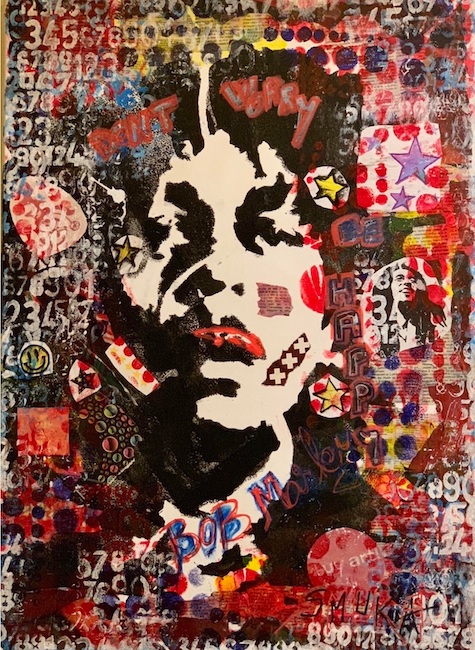
In Bob Marley invece l’artista riprende il tema della composizione dello sfondo tramite lettere tanto cara ad Alighiero Boetti che però in questa tela sono funzionali a mettere in risalto l’autorialità di un mostro sacro della musica reggae, magnifico paroliere di testi indimenticabili, e a contornare la sua immagine iconica nota in tutto il mondo. Sembra emergere una sorta di nostalgia da parte della Codrea per un personaggio che ha saputo lasciare un segno profondo nella musica del Novecento e i cui messaggi sono tutt’oggi incredibilmente attuali; anche in questo caso la colorazione intensa e fluo appare come perfetta congiunzione tra esteriorità del visibile, di ciò che l’immagine del cantante ha rappresentato e interiorità dell’emozione, della capacità di far vibrare le corde interiori che permane malgrado la sua scomparsa. Quando si allontana dal Pop Anca Codrea lascia prevalere il mondo interiore, quell’universo emozionale in virtù del quale riesce a lasciarsi andare ai ricordi, alle sensazioni che i fiori suscitano in lei oppure i timori e le inquietudini che appartengono all’uomo contemporaneo sebbene la tendenza sia quella di non guardarli, di lasciarli inespressi o in silenzio coperti dal rumore della quotidianità.
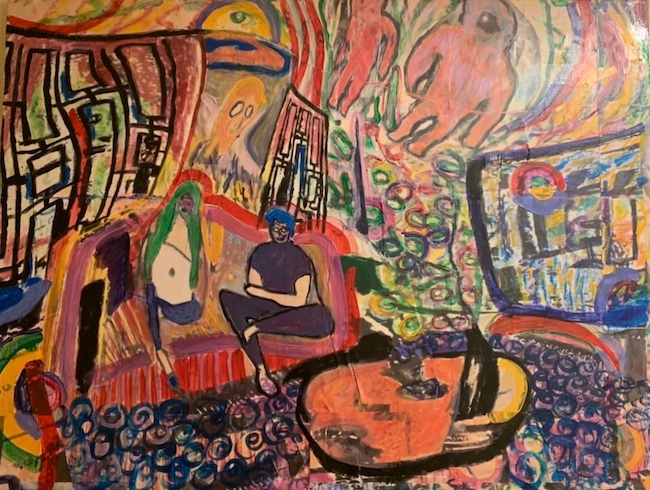
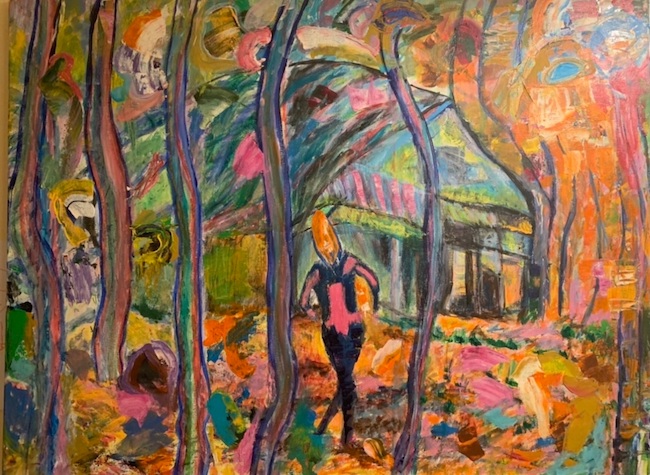
A questa serie di opere più turbate appartengono The astronauts e The eye in cui emerge una leggera e confusa figurazione che sembra contribuire a svelare il senso di disorientamento che l’artista vive quando riflette sul presente e sul futuro che l’essere umano sta vivendo in questo delicato momento della storia attuale; i disegni sono semplificati alla maniera espressionista per narrare personaggi provenienti da un mondo a metà tra sogno e incubo, dove però il desiderio di mantenere uno sguardo positivo si manifesta dalla gamma cromatica utilizzata, come se l’artista esortasse l’osservatore a mantenere il contatto con le infinite possibilità che possono aprirsi e che non necessariamente devono indurre la mente a crogiolarsi e a soffermarsi su un momento apparentemente cupo e negativo.
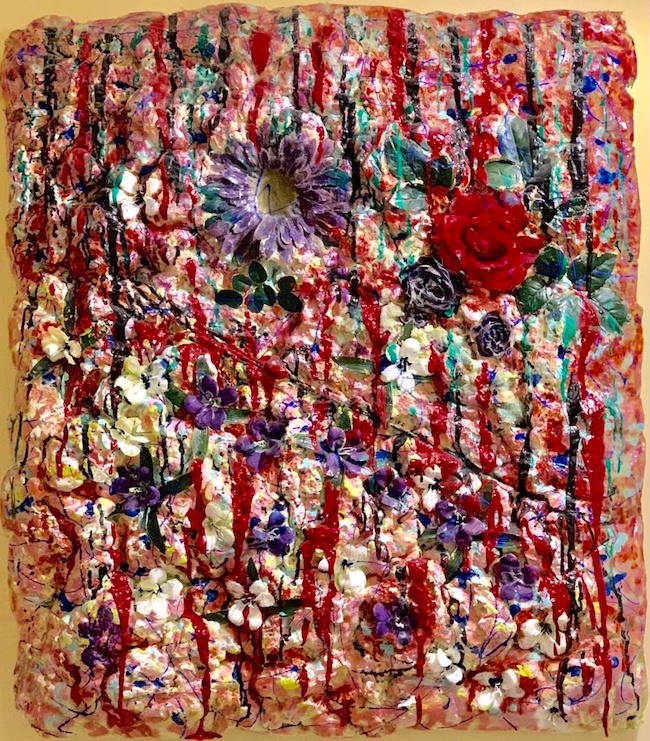
Poi invece nelle tele in cui narra il piacere che prova quando entra in contatto con la natura, Anca Codrea lascia emergere il suo lato più emozionale, più legato al ricordo di un momento passato eppure ancora presente nella sua memoria, come in Nostalgia in cui il predominante colore rosso e l’introduzione dell’elemento materico sembrano scolpire le sensazioni provate, la passione che era stata in grado di accendere il suo animo propagandosi al frangente vissuto, e in Sunflowers in cui a predominare è invece l’allegria di un giorno di sole, di un momento spensierato e intenso tale da farle sentire il bisogno di immortalare quell’istante sulla tela.

Anca Codrea inizia a dipingere nel 2010, dopo aver collaborato per anni con un’azienda internazionale, da quel momento la sua vita è cambiata e si è dedicata completamente all’arte; ha esposto le sue opere al Grand Palais di Parigi, a Bruxelles e a Bruges in prestigiose gallerie e palazzi istituzionali.
ANCA CODREA-CONTATTI
Email: ancacodrea2017@gmail.com
Facebook: https://www.facebook.com/anca.codrea.98
Linkedin: https://www.linkedin.com/in/ancacodreacoach/
Instagram: https://www.instagram.com/ancacodreacoachingandart/
Pop Art and Abstract Expressionism meet in the lively artworks of Anca Codrea
Contemporary art has the singular characteristic of being a point of union, a connection between different forms of expression that might seem to be opposites, yet able to harmonise and give life to the new that constitutes the very essence of creativity. In this way, the artistic manifestation becomes research, experimentation, not only a narration of everything that belongs to the interiority but an attempt to combine the ephemeral with the substantial, the appearance with the essence. It is precisely this stylistic ability to move on two different yet amalgamable fronts that distinguishes today’s protagonist.
Around the middle of the twentieth century, when all previous currents of painting had fought their ideological battle against Classicism, figuration and the academic dogmas on which art had been based until the end of the nineteenth century, began to emerge new movements which on the one hand sought to regain contact with the inner world, the emotionality that had been put on the back burner in the process of analysis, the search for a way to make the plastic gesture prevail over the observed reality and the detachment from any hint of the rules of previous painting, and on the other they moved towards a representation of the new society of the time with all the characteristics that distinguished it. Abstract Expressionism recovered all the emotional connotations that had been lost with Geometric Abstractionism, Conceptualism, Material Informalism and Spatialism, to name but a few of the main movements, forcefully and impetuously reaffirming the importance of listening to the inner self and the artist’s ability to interpret the observed, which could not be detached from the plastic gesture; on the other hand, Pop Art proposed to continue the analysis of contemporary life, not only setting aside emotions, except for those linked to the pursuit of consumerism or the myth that was now able to enter people’s homes, but also bringing the image and figuration closer to the general public through a familiar, known language.
Apparently distant from each other but incredibly similar in their artistic intentions, Jackson Pollock and Andy Warhol both wanted to find a more direct dialogue with the public, trying to get art out of the intellectual salons and into the hands of the people, who, despite not knowing the rules of painting, might have felt involved in the emotional impetus, in the case of Abstract Expressionism, or in the knowledge of the subjects portrayed because they belonged to their everyday life, in the case of Pop Art. From Jackson Pollock’s more impetuous Dripping and Mark Rothko’s more meditative Colour field, we moved on in the same period to the comic strip characters mixed with Roy Lichtenstein’s pointillism or Andy Warhol’s brightly coloured film myths, both styles capable of engaging and exciting the public. The Romanian-born artist, who has lived in Brussels for many years, Anca Codrea, mixes the two styles together to generate her own personal language in which Pop tries to prevail over Abstractionism and Abstractionism proves to be a co-protagonist capable of exalting and highlighting the icons of comics, filmography and music of a past that is ideally distant but temporally still close to contemporaneity. Not only, Anca Codrea dares improbable binomials, such as the one he hypothesises in the canvas Kate and Chaplin, where the unforgettable Tramp secretly observes, as in the famous photo taken from the film The Kid, the beauty of an unaware Kate Moss, who shows herself sullenly to the observer, as if in the end her life, coveted by many girls, was boring, repetitive, unsatisfactory for those inner chords to which every human being tends. And it is the Tramp who plays that human role in the canvas, that tender, playful, curious and sensitive being who re-establishes the balance between form and essence; the colour is applied in an abstract, irregular way, partly by light dripping and partly by applying random touches, to give the sense of unreality already evident from the juxtaposition of the two protagonists.
In Mickey, Codrea lets out all her self-ironic vein, her positive and smiling approach to life, which is fundamental in not taking herself too seriously and in facing what happens with the ability to extrapolate the best side of events, to laugh at ourselves because this is what allows us to overcome with greater ease the events that inevitably occur. In this case, too, abstraction becomes a secondary element in the figuration, because the image of Mickey Mouse, amused but in black and white, is accompanied by bright, intense colours in predominantly pink and blue tones, as if they were the musical notes of a carefree pop life. In Bob Marley, on the other hand, the artist takes up the theme of the composition of the background by means of letters, so dear to Alighiero Boetti, but in this canvas they are used to highlight the authorship of a sacred monster of reggae music, a magnificent lyricist of unforgettable texts, and to surround his iconic image known throughout the world. Codrea seems to feel a sort of nostalgia for a character who left a profound mark on the music of the twentieth century and whose messages are still incredibly relevant today. Here too, the intense, fluorescent colouring appears to be the perfect link between the exteriority of the visible, of what the singer’s image represented, and the interiority of the emotion, the ability to make inner chords vibrate, which remains despite his death. When she moves away from Pop Art, Anca Codrea lets her inner world prevail, that emotional universe by virtue of which she is able to let herself go to memories, to the sensations that flowers arouse in her or the fears and anxieties that belong to contemporary man, even though the tendency is not to look at them, to leave them unexpressed or silently covered by the noise of everyday life.
To this series of more troubled works belong The astronauts and The eye in which emergese a light and confused figuration that seems to contribute to reveal the sense of disorientation that the artist experiences when she reflects on the present and the future that the human being is experiencing in this delicate moment of current history; the drawings are simplified in an expressionist manner to narrate characters from a world halfway between a dream and a nightmare, but where the desire to maintain a positive outlook is manifested in the range of colours used, as if the artist were urging the observer to maintain contact with the infinite possibilities that may open up and which do not necessarily have to lead the mind to wallow and dwell on an apparently gloomy and negative moment. Then, however, in the canvases in which she narrates the pleasure she feels when she comes into contact with nature, Anca Codrea lets emerge her more emotional side, more linked to the memory of a past moment yet still present in her memory, as in Nostalgia in which the predominant red colour and the introduction of the material element seem to sculpt the sensations felt, the passion that had been able to ignite her soul, spreading to the event she had experienced, and in Sunflowers, where the predominant colour is the joy of a sunny day, of a carefree and intense moment that made her feel the need to immortalise that instant on canvas. Anca Codrea began painting in 2010, after working for years with an international company. From that moment on, her life changed and she dedicated herself completely to art; she has exhibited her works at the Grand Palais in Paris, in Brussels and in Bruges in prestigious galleries and institutional buildings.


